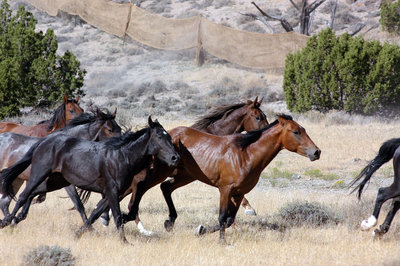
Roughly 67,000 wild horses roam the public lands of the western United States, and around 4,000 of them are in Oregon.
The federal Bureau of Land Management (BLM) considers the current population to be more than double the healthy level for the land and has suppressed the population for decades. Many mustang advocacy groups strongly oppose the BLM’s methods and motives for population control and believe that the agency gives preferential treatment to livestock.
Despite recent public outcry, the BLM has announced an experiment to sterilize wild horses held in Hines, Oregon, in a partnership with Oregon State University (OSU). The BLM has approved two grants to OSU totaling $348,000 to study wild horse sterilization.
The proposed experiment that has caused the most outcry involves a surgical spay procedure called “ovariectomy via colpotomy,” in which a veterinarian removes the ovaries from the horse with a tool with a chain or loop called an ecraseur. Some scientists and advocacy groups have described this surgery as “barbaric, invasive and dangerous.”
The American Wild Horse Preservation Campaign (AWHPC) has been among the most vocal opponents to the BLM’s proposal. AWHPC is a coalition dedicated to preserving American wild horses and burros. AWHPC has filed a series of complaints to the BLM and OSU about the proposed experiments and led a public campaign in which 21,000 people submitted public comments in opposition to the experiment.
AWHPC has urged the BLM to use the PZP (porcine zona pellucida) birth control vaccine, a noninvasive method that the group says has a 98 percent efficacy rate in the first year after application and can last for up to three years.
“The BLM has a history of failing to utilize humane birth control to manage wild horses,” AWHPC Executive Director Suzanne Roy tells EW. “The PZP birth control vaccine has been available for about 30 years, and the BLM has consistently failed to use it. Now they’ve reached this crisis stage.”
Many of the horses selected for the ovariectomy via colpotomy surgery are pregnant and some are only eight months old, according to the BLM. The pregnant horses have a higher risk of death and long-term complications.
Oregon veterinarian Leon Pielstick conducted this surgery in a workshop last year and two of the five horses died, while two others required extensive post-operative care, according to AWHPC. The horses in this workshop were tame, and AWHPC believes that if they had been wild they would not have access to post operative care. OSU and the BLM have said that if the death rate exceeds 20 percent, they will stop the experiment.
“Twenty percent of 25 horses is not that much,” says BLM Burns District Wild Horse and Burro Specialist Lisa Grant.
One hundred horses will be selected for the surgery. Twenty horses would have to die to stop the experiment. In an FAQ in response to the concerns about the procedure, OSU writes, “University-wide commitment to animal care, safety and welfare is a top priority.”
Ginger Kathrens, humane representative on the BLM National Wild Horse and Burro Advisory Board, has worked with wild horses for more than 20 years. Kathrens founded the Cloud Foundation, a nonprofit that is dedicated to preventing the extinction of wild horses in the western U.S. She was appointed to the BLM Advisory Board after the recent vote to conduct the experiment in Burns.
“Why in the world are we researching ovariectomy via colpotomy?” Kathrens asks. “This surgery is not practical unless you don’t care if a significant portion of the animals die.”
Wild horses inhabit 12 percent of BLM land and account for about 20 percent of the land’s forage, whereas livestock account for about 80 percent of the forage. Ranchers are permitted to graze their livestock on BLM land for substantially lower than market rate.
Advocates fear that the BLM is not acting in the best interests of the public. AWHPC has cited polls that show that three out of four Americans support protecting the country’s wild horses on public lands in a humane manner.
“The BLM’s whole agenda is to continue their unsustainable practice of rounding up wild horses and the goal is to legalize the slaughter of wild horses,” Roy tells EW. “That’s where they’re heading.”